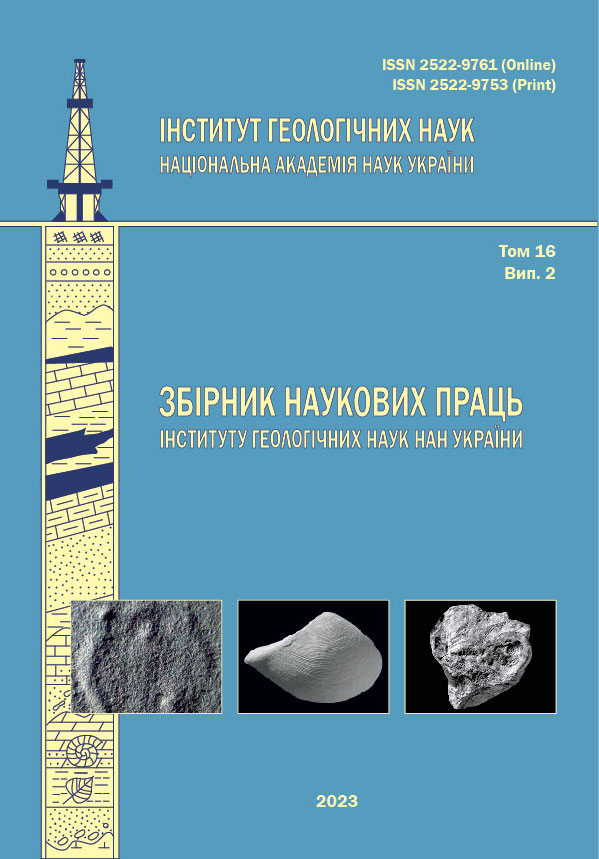ОГЛЯД СУЧАСНИХ ТЕХНОЛОГІЙ «МОНІТОРИНГУ СТРУКТУРНОГО ЗДОРОВ'Я» (SHM) ІСТОРИЧНИХ БУДІВЕЛЬ В СКЛАДНИХ ІНЖЕНЕРНО-ГЕОЛОГІЧНИХ УМОВАХ: ДАТЧИКИ, МЕТОДИ АНАЛІЗУ ДАНИХ І ПЕРСПЕКТИВИ ЗАСТОСУВАННЯ В УКРАЇНІ
DOI:
https://doi.org/10.30836/igs.2522-9753.2023.293237Ключові слова:
збереження пам’яток архітектури, інженерно-геологічні умови, тріщиноутворення, деформації споруд, акселерометри, GPS-пристроїАнотація
Представлено короткий огляд сучасних технологій «моніторингу структурного здоров’я» (Structural Health Monitoring – SHM) будівельних конструкцій. Основну увагу приділено аналізу світового досвіду та особливостям застосування SHM до історичних пам’яток, які знаходяться в складних інженерно-геологічних умовах і зазнають впливів небезпечних геологічних процесів. Розглянуто цілі і принципи методу. Виконано огляд основних типів інструментальних датчиків (зокрема, акселерометрів, датчиків акустичної емісії, GPS-датчиків і датчиків умов навколишнього середовища). Розглянуто методи математичного аналізу й інтерпретації потоків отриманих даних. Показано актуальність застосування сучасних технологій SHM для архітектурних пам’яток Національного заповідника «Києво-Печерська лавра», які розташовані в складних інженерно-геологічних умовах і зазнають небезпечних впливів від природних (зсувні процеси, метеорологічні фактори) і техногенних факторів (перезволоження ґрунтів фундаментів внаслідок витоків із інженерних мереж, вібраційні навантаження від транспорту, вибухових хвиль внаслідок воєнних дій тощо). Обговорено пілотний досвід і перспективи застосування методології SHM до об’єктів Національного заповідника «Києво-Печерська лавра». Описано роботи з тестування датчиків (акселерометри, велосіметри, лазерний інклінометр) для реєстрації віброметричних, сейсмічних і деформаційних впливів на об’єкти Заповідника. Представлено метод автоматичного виділення корисного сигналу типу «мікротріщина» для акселерометричного датчика. Наведено результати тестової експлуатацію 3D лазерного інклінометра для дослідження напрямків сповзання і деформації історичних будівель споруд, зокрема, внаслідок зсувів і просадок ґрунту та ін.
Посилання
Demchyshyn M. G., Kril T. V., 2019. Improvement of the Engineering Protection Systems of the Kyiv-Pechersk Lavra Reserve Territory. Nauka innov. No 15(3), Pp. 37–51. (In Ukrainian) https://doi.org/10.15407/scin15.03.037
Cherevko I., Zatserkovnyi V., Trofymenko P. et al., 2022. Application of the geodatabase of regime of hydrogeological conditions of the Kyiv Cave Monastery and its analysis. Bulletin of Taras Shevchenko Kyiv National University. Geology, No 3(98). Pp. 92–103. (In Ukrainian) https://doi.org/10.17721/1728-2713.98.12
Barsocchi P., Bartoli G., Betti M., et al., 2021. Wireless Sensor Networks for Continuous Structural Health Monitoring of Historic Masonry Towers. Int. J. Archit. Herit. No 15, Pp. 22–44. https://doi.org/10.1080/15583058.2020.1719229
Behnia A., Chai H.K., Shiotani T. 2014: Advanced structural health monitoring of concrete structures with the aid of acoustic emission. Constr. Build. Mater. No 65, Pp. 282–302. https://doi.org/10.1016/j.conbuildmat.2014.04.103
Carpinteri A., Invernizzi S., Lacidogna G. 2007. Structural assessment of an XVIIth century masonry vault with AE and numerical techniques. Int. J. Architec. Heritage. No 2, Pp. 214–226.
Carrasco Á., Méndez F., Leaman F. et al., 2021. Short Review of the Use of Acoustic Emissions for Detection and Monitoring of Cracks. Acoust. Aust. No 49, Pp. 273–280. https://doi.org/10.1007/s40857-021-00219-4
Fiorucci M., Khoroshiltseva Ma., Pontil M., et al., 2020. Machine Learning for Cultural Heritage: A Survey. Pattern Recognition Letters. No 133, Pp. 102–108. https://doi.org/10.1016/j.patrec.2020.02.017
Gattulli V., Lepidi M., Potenza F., 2016. Dynamic testing and health monitoring of historic and modern civil structures in Italy. Struct. Monit. Maint. No 3, Pp. 71–90. https://doi.org/10.12989/smm201631071
Gopinath V.K., Ramadoss R., 2021. Review on structural health monitoring for restoration of heritage buildings, Materials Today: Proceedings. No 43(2), 2021, Pp. 1534–1538. https://doi.org/10.1016/j.matpr.2020.09.318
Han G., Y.-M. Kim, H. Kim, T.-M. Oh, K.-I. Song, A. Kim, Y. Kim, Y. Cho, T.-H. Kwon, 2021. Auto-detection of acoustic emission signals from cracking of concrete structures using convolutional neural networks: Upscaling from specimen, Expert Systems with Applications, 186, 115863. https://doi.org/10.1016/j.eswa.2021.115863
Im S.B., Hurlebaus S., Kang Y.J., 2013. Summary review of GPS technology for structural health monitoring. J. Struct. Eng. No 139, Pp. 1653–1664. https://doi.org/10.1061/(ASCE)ST1943-541X0000475
Kilic G. 2015. Using advanced NDT for historic buildings: Towards an integrated multidisciplinary health assessment strategy. J. Cult.Herit. 16, Pp. 526–535. https://doi.org/10.1016/j.culher.2014.09.010
Kita A., Cavalagli N., Venanzi I., Ubertini, F., 2021. A new method for earthquake-induced damage identification in historic masonry towers combining OMA and IDA. Bull. Earthq. Eng. No 19, Pp. 5307–5337. https://doi.org/10.1007/s10518-021-01167-0
Kołakowski P., 2007. Structural health monitoring – A review with the emphasis on low-frequency methods. Engng. Trans. No 55 (3), Pp. 239–275. https://doi.org/10.24423/engtrans.220.2007
Liu Q., Liu Qi, Pan Y., et al., 2018. Microcracking Mechanism Analysis of Rock Failure in Diametral Compression Tests. J. Mater. Civ. Eng., No 30(6), 04018082. https://doi.org/10.1061/(ASCE)MT.1943- 5533.0002251
López-Castro B., Haro-Baez A.G., Arcos-Aviles D., et al., 2022. A Systematic Review of Structural Health Monitoring Systems to Strengthen Post-Earthquake Assessment Procedures. Sensors. 22, 9206. https://doi.org/10.3390/s22239206
Lorenzoni, F., Casarin, F., Modena, C. et al., 2013. Structural health monitoring of the Roman Arena of Verona, Italy. J. Civil. Struct. Health Monit. No 3, Pp. 227–246. https://doi.org/10.1007/s13349-013-0065-0
Mishra M., 2021. Machine learning techniques for structural health monitoring of heritage buildings: A state-of-the-art review and case studies. J. Cult. Heritage, No 47, Pp. 227–245. https://doi.org/10.1016/j.culher.2020.09.005
Moreno-Gomez A., Perez-Ramirez C.A., Dominguez-Gonzalez A. et al., 2018. Sensors Used in Structural Health Monitoring. Arch Computat Methods Eng. No 25, Pp. 901–918. https://doi.org/10.1007/s11831-017-9217-4
Saisi A., Gentile C., Guidobaldi M. 2015. Post-earthquake continuous dynamic monitoring of the Gabbia Tower in Mantua, Italy. Constr. Build. Mater. No 81, Pp.101–112. https://doi.org/10.1016/jconbuildmat201502010
Sivasuriyan A., Vijayan D.S.; Górski W., et al., 2021. Implementation of Structural Health Monitoring in Multi-Story Buildings. Buildings. No 11, 263 p. https://doi.org/10.3390/buildings11060263
Soleymani A., Jahangir H., Nehdi M.L., 2023. Damage detection and monitoring in heritage masonry structures: Systematic review, Constr. Build. Materials. No 397, 132402. https://doi.org/10.1016/j.conbuildmat.2023.132402
Ubertini F., Comanducci G., Cavalagli N. et al., 2017. Environmental effects on natural frequencies of the San Pietro bell tower in Perugia, Italy, and their removal for structural performance assessment. Mech. Syst Signal Process. No 82, Pp. 307–322. https://doi.org/10.1016/jymssp201605025
Venanzi I., Kita A., Cavalagli N., et al., 2020. Earthquake-induced damage localization in a historic masonry tower through long-term dynamic monitoring and FE model calibration. Bull. Earthquake Eng. No 18, Pp. 2247–2274. https://doi.org/10.1007/s10518-019-00780-4
Xu J., Han Q., Xu Y., 2016. Application of Acoustic Emission Technique in the Monitoring of Masonry Structures. Non-Destructive Testing. In book: Non-destructive testing. http://dx.doi.org/10.5772/63093
Zárate B., Caicedo J., Yu J, Ziehl P,. 2012. Probabilistic prognosis of fatigue crack growth using acoustic emission data. J. Eng. Mech. No 138, Pp. 1101–1111. https://doi.org/10.1061/(ASCE)EM1943-78890000414
Zini G.; Betti M.; Bartoli G., 2022. A pilot project for the long-term structural health monitoring of historic city gates. J. Civ. Struct. Health Monit. No 12, Pp. 537–556. https://doi.org/10.1007/s13349-022-00563-7
Zonno G., Aguilar R.; Boroschek R., Lourenço P.B., 2018. Automated long-term dynamic monitoring using hierarchical clustering and adaptive modal tracking: Validation and applications. J. Civ. Struct. Health Monit. No 8. Pp. 791–808. https://doi.org/10.1007/s13349-018-0306-3


